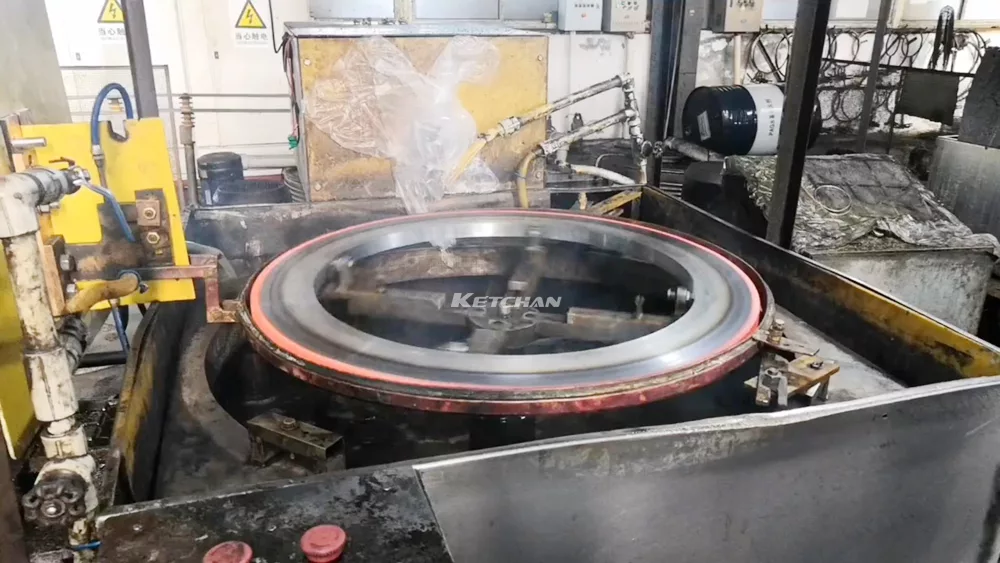
Heat treatment for gears is a process of altering the physical and mechanical properties of gears by applying heat and cooling cycles. The purpose of heat treatment is to improve the performance, durability, and wear resistance of gears. There are different types of heat treatment processes for gears, such as neutral hardening, carburizing, nitriding, induction hardening, etc. Each process has its own advantages and disadvantages depending on the gear material, design, and application.
Some of the methods of gear heat treatment are:
- Neutral hardening: This is a process of heating the gears to a high temperature and then quenching them in oil or water to achieve a uniform hardness throughout the gear. This process is suitable for gears that require high strength and toughness, but not high wear resistance.
- Carburizing: This is a process of heating the gears in a carbon-rich atmosphere and then quenching them to increase the carbon content of the surface layer. This process creates a hard and wear-resistant case and a softer and tougher core. This process is suitable for gears that require high surface hardness and fatigue resistance, but not high core strength1.
- Nitriding: This is a process of heating the gears in a nitrogen-rich atmosphere and then cooling them slowly to form a thin layer of nitrides on the surface. This process improves the surface hardness, wear resistance and corrosion resistance of the gears, but does not affect the core properties. This process is suitable for gears that require low distortion and high surface quality, but not high core strength1.
- Induction hardening: This is a process of heating the gears with an electric current that passes through a coil around them. The current induces eddy currents in the gears, which generate heat according to the Joule–Lenz law. The heat penetrates the surface of the gears and changes their microstructure, making them more resistant to wear and tear. This process is suitable for gears that require localized hardening and low distortion, but not high core strength.
What are the advantages of gear hardening heat treatment?
Some of the advantages and disadvantages of each method are:
- Neutral hardening: The advantages of this method are that it provides high strength and toughness throughout the gear, and it does not require a special atmosphere or equipment. The disadvantages are that it causes high distortion and residual stresses in the gear, and it does not improve the wear resistance or fatigue life of the gear surface.
- Carburizing: The advantages of this method are that it provides high surface hardness and fatigue resistance, and it can be applied to low-carbon steels. The disadvantages are that it requires a special atmosphere and equipment, and it causes high distortion and residual stresses in the gear. It also reduces the core strength and toughness of the gear.
- Nitriding: The advantages of this method are that it provides high surface hardness, wear resistance, and corrosion resistance, and it causes low distortion and residual stresses in the gear. It also does not require quenching or tempering. The disadvantages are that it requires a special atmosphere and equipment, and it can only be applied to nitride-able steels. It also does not improve the core strength or toughness of the gear.
- Induction hardening: The advantages of this method are that it provides localized hardening and low distortion in the gear, and it does not require a special atmosphere or equipment. It also allows for selective hardening of specific areas of the gear. The disadvantages are that it requires a high electric current and a coil, and it can only be applied to electrically conductive steels. It also does not improve the core strength or toughness of the gear.
How does gear induction hardening ensure product consistency?
Gear hardening with induction heating increases the hardness and durability of gears made of low-carbon steel by heating them with an electric current that passes through a coil around them. The current induces eddy currents in the gears, which generate heat according to the Joule–Lenz law. The heat penetrates the surface of the gears and changes their microstructure, making them more resistant to wear and tear.
Gear induction hardening ensures product consistency by controlling the parameters of the process, such as the electric current, frequency, coil design, heating time, quenching medium, and temperature. These parameters affect the depth, hardness, and uniformity of the hardened layer on the gear surface. By optimizing and monitoring these parameters, gear induction hardening can produce gears with consistent quality and performance.
